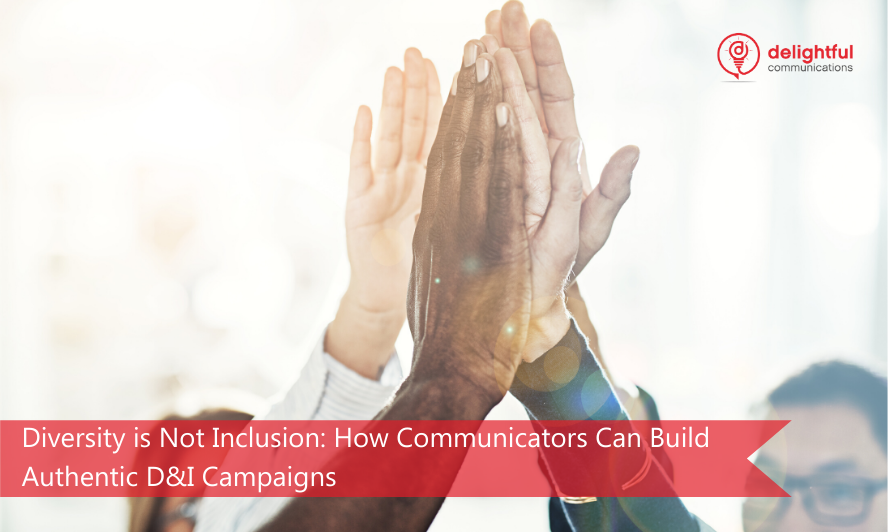At the Ragan & PR Daily Conference our team attended in September, we were able to catch the presentation of Janet M. Stovall, executive communications director at UPS. Much to our surprise, Stovall is the only female, person-of-color speechwriter in the Fortune 500. (As she notes, there are usually more found in political speech writing, but still not in corporations.)
With yesterday marking Latina Equal Pay Day, Stovall’s keynote came back to mind as a valuable discussion to share. Especially as we enter the heavy, consumer-focused marketing of the holiday season. While it’s gotten better, many of these commercials only showcase a modern look at the same families featured decades ago.
Diversity in Communications: Where do we start?
Spearheading the ever-important conversation around diversity in communications, Stovall’s conversation and Q&A session was a big hit. Not only was the crowd receptive, but they were highly interested in how to create a company-wide focus on diversity.
Stovall recommended a book and Ted Talk by Simon Sinek, titled, “Start with Why: How Great Leaders Inspire Everyone to Take Action” (Ted Talk, here). With over 47 MILLION views, there’s no doubt as to why it’s seen as a great resource. The video pushes communicators to think big-picture and recognize the importance of asking ‘why?’ Stovall suggests that asking ‘why?’ is the easiest place to start rethinking D&I.
As Stovall broke down, D&I still isn’t diverse or inclusive. In most D&I campaigns, representation is still lacking and is, on average, depicted as 87.9% White, 8.3% African American, 5.7% Latinx, and 2.6% Asian American.
She asks the room whether this sounds right to us, receiving a resounding ‘no,’ in the ashamed silence of the room.
Presenting the Value of Diversity to Reluctant Leadership
Stovall urges that executives should play a larger role and be required to have tactical understandings of diversity and inclusion. This is regardless of whether they’re a person of color, or non-conforming to any sexual or gender norms, or of any ability level.
She approached the interesting question of presenting value to leaders who may be less understanding, aware, or interested in D&I: How can you convince, if necessary, your company’s leaders to complete D&I training?
Her answer: show them the impact on your employees and your business. Express to them the importance of diverse representation, perspective, and models of business. It needs to be depicted as an opportunity for business growth, not framed as punishment for not having done enough historically.
Diversity is NOT Inclusion
Stovall shares her understanding of D&I and how the two are inherently different from one another. She iterates, “diversity is NOT inclusion.” She breaks it down further, showing the separation of the two to explain their differences. She clarifies to the audience that both are equally important to apply.
Diversity, she says, is numbers. It is fact-driven, and it’s something you naturally HAVE, which means it takes intention to stop being diverse; it’s more innate. She also claims that, as opposed to inclusion, diversity is more aspirational.
Thus, she details Inclusion is the opposite. Its impact. It is choice-based, it’s something you DO, not necessarily something you HAVE; the point of inclusion is that it takes intention to START, and it’s an actionable objective, rather than something innate.
Both, she clarifies, are equally important. It allows companies to properly execute campaigns and have a better understanding of D&I for their brand.
Likewise, Stovall cautions the crows with the horror stories of poorly executed, cliché, but still common, marketing campaigns. We glance up at a photo of the group where almost every individual is a person of color, and female. She explains how you can’t force diversity. It’ll always be shockingly apparent when people tick off boxes, which leads to uncomfortable campaigns that are too on-the-nose.
Authenticity and Diversity: Building Successful Campaigns
As Stovall practices at UPS, it takes time and thoughtful consideration to properly and appropriately land the message of diversity in a way that’s natural and authentic. She works with her teams at UPS to make sure people of color and all gender/sexual identities are involved throughout the process of building any campaign out. It the result is an inaccurate representation, they go back to the drawing board. Her team is unafraid of being resource-selfish if it means executing the campaign properly.
Bonus Tip: Always Provide a Seat at the Table
As a Latinx woman, I resonated with Stovall’s presentation. At times like the holidays, I find myself hyper-aware of how campaigns portray and include or exclude demographic minorities. Still, I’m often disappointed to not see individuals like myself, or rather, see them misrepresented instead.
Latina Equal Pay Day is one of many reminders for businesses to push themselves to promote equity in more than just marketing campaigns. Inclusivity leads to unity, which benefits all parties involved.
A few tips from my playbook? Always provide a seat at the table to uplift someone who doesn’t look, sound, or come from the same place you do.
Ask for another’s take when you’re representing a gender, culture, language, or sexuality that doesn’t belong to you. It’s not embarrassing; rather, it’s encouraging to those you ask for advice. It shows that diversity and inclusion matter. Because they do.
At Delightful Communications, by ‘Celebrating Uniqueness,’ we make sure our team varies in experiences and cultural backgrounds. It’s not only about representing your organization as diverse and inclusive but practicing this methodology, just the same.
Thanks for reading,
Victoria Solis – Executive Communications & Branding Strategist, Delightful Communications
Don’t forget to: subscribe to The Personal Brand Lab, follow @Delightful on Twitter, like the Delightful Facebook Page, and join us on LinkedIn.



